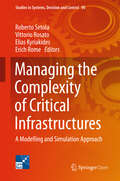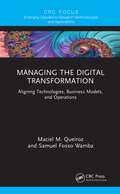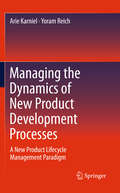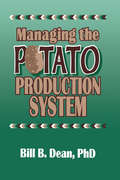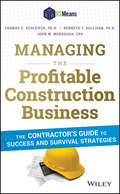- Table View
- List View
Managing Sustainable Development Programmes: A Learning Approach to Change
by Gran Brulin Lennart SvenssonProject work, driven by competent project leaders drives positive outcomes. Unfortunately these optimistic initial results are often short-sighted with few evaluations of their long-term impact. The research contained in Managing Sustainable Development Programmes reveals an extraordinary level of failure in the durability of large change programmes and projects in both the private and public sectors. In this book the authors question whether sustainable development be achieved within the framework of large publicly financed programmes. This strong critique of traditional programme implementation overturns much of our current thinking about project delivery and governance. The authors focus instead on sustainable change and development. They show how active ownership and collaboration between different actors and the dynamics of developmental learning can be used to create programmes and projects that contribute to innovation, employment and growth in a way that favours companies, employees, customers and society in a broader sense. The message at its heart is 'don't blame the project leader' but rather look for dynamic possession of projects, joint knowledge management and sharing with external stakeholders that will secure long-term effects.
Managing Sustainable Development Programmes: A Learning Approach to Change
by Gran Brulin Lennart SvenssonProject work, driven by competent project leaders drives positive outcomes. Unfortunately these optimistic initial results are often short-sighted with few evaluations of their long-term impact. The research contained in Managing Sustainable Development Programmes reveals an extraordinary level of failure in the durability of large change programmes and projects in both the private and public sectors. In this book the authors question whether sustainable development be achieved within the framework of large publicly financed programmes. This strong critique of traditional programme implementation overturns much of our current thinking about project delivery and governance. The authors focus instead on sustainable change and development. They show how active ownership and collaboration between different actors and the dynamics of developmental learning can be used to create programmes and projects that contribute to innovation, employment and growth in a way that favours companies, employees, customers and society in a broader sense. The message at its heart is 'don't blame the project leader' but rather look for dynamic possession of projects, joint knowledge management and sharing with external stakeholders that will secure long-term effects.
Managing Technological Innovation: Competitive Advantage from Change
by Frederick BetzWritten by the author who helped crystalize the field of technology management and the management of innovation with the first two editions of Managing Technological Innovation, this Third Edition brings the subject in line with current business strategy. It also presents information in a newer organized format that aligns more closely with how the topics are presented and discussed in the classroom. Also included is a wider discussion of how science and technology interact with the global economy.
Managing Technological Innovation: Competitive Advantage from Change
by Frederick BetzWritten by the author who helped crystalize the field of technology management and the management of innovation with the first two editions of Managing Technological Innovation, this Third Edition brings the subject in line with current business strategy. It also presents information in a newer organized format that aligns more closely with how the topics are presented and discussed in the classroom. Also included is a wider discussion of how science and technology interact with the global economy.
Managing Technology and Innovation: An Introduction
by Robert Verburg J. Roland Ortt Willemijn M. DickeModern technology and innovation are vital to the success of all companies, be they hi-tech firms or companies seemingly unaffected by technology and innovation; whether established firms or business start-ups. This book focuses on understanding technology as a corporate resource, covering product development, design of systems and the managerial aspects of new and high technology. Topics investigated include: the internal organization of high technology firms the management of technology in society managing innovation dilemmas and strategies. The wide-ranging experience of the teachers and experts contributing to this book has resulted in an integrated, multi-disciplinary, textbook that provides an introductory overview to managing technology and innovation in the twenty-first century. This text is essential reading for students of business and engineering concerned with technology and innovation management.
Managing Technology and Innovation: An Introduction
by Robert Verburg J. Roland Ortt Willemijn M. DickeModern technology and innovation are vital to the success of all companies, be they hi-tech firms or companies seemingly unaffected by technology and innovation; whether established firms or business start-ups. This book focuses on understanding technology as a corporate resource, covering product development, design of systems and the managerial aspects of new and high technology. Topics investigated include: the internal organization of high technology firms the management of technology in society managing innovation dilemmas and strategies. The wide-ranging experience of the teachers and experts contributing to this book has resulted in an integrated, multi-disciplinary, textbook that provides an introductory overview to managing technology and innovation in the twenty-first century. This text is essential reading for students of business and engineering concerned with technology and innovation management.
Managing Technology and Middle- and Low-skilled Employees: Advances for Economic Regeneration (The Changing Context of Managing People)
by Professor Claretha Hughes Associate Profes Lionel Robert Assistant Profes Kristin Frady Dr Adam ArroyosAs technological change and digital disruption becomes normalized in the fourth industrial revolution, workplace leaders are seeking new solutions to evolving problems. Managing Technology and Middle- and Low-Skilled Employees is an illuminating study of workplace leadership for improving the employee experience and adjusting the organizational culture to reduce tensions between technology and people at work. Reliance on artificial intelligence has created apprehension and anxiety among some employees and the general public as they try to understand whether or not employees will be replaced by new technologies. This book examines technological developments, such as artificial intelligence and big data, and reveals the practical implications of how people and new technologies can co-exist, harmoniously, within the workplace through virtual teams. Managing Technology and Middle- and Low-Skilled Employees offers routes to new solutions for scholars and professionals in the fields of business, human resource development, human resource management, information systems, and workforce development.
Managing Technology and Middle- and Low-skilled Employees: Advances for Economic Regeneration (The Changing Context of Managing People)
by Professor Claretha Hughes Associate Profes Lionel Robert Assistant Profes Kristin Frady Dr Adam ArroyosAs technological change and digital disruption becomes normalized in the fourth industrial revolution, workplace leaders are seeking new solutions to evolving problems. Managing Technology and Middle- and Low-Skilled Employees is an illuminating study of workplace leadership for improving the employee experience and adjusting the organizational culture to reduce tensions between technology and people at work. Reliance on artificial intelligence has created apprehension and anxiety among some employees and the general public as they try to understand whether or not employees will be replaced by new technologies. This book examines technological developments, such as artificial intelligence and big data, and reveals the practical implications of how people and new technologies can co-exist, harmoniously, within the workplace through virtual teams. Managing Technology and Middle- and Low-Skilled Employees offers routes to new solutions for scholars and professionals in the fields of business, human resource development, human resource management, information systems, and workforce development.
Managing Technology and Product Development Programmes: A Framework for Success
by Peter FlinnAn authoritative guide to new product development for early career engineers and engineering students Managing Technology and Product Development Programmes provides a clear framework and essential guide for understanding how research ideas and new technologies are developed into reliable products which can sold successfully in the private or business marketplace. Drawing on the author’s practical experience in a variety of engineering industries, this important book fills a gap in the product development literature. It links back into the engineering processes that drives the actual creation of products and represents the practical realisation of innovation. Comprehensive in scope, the book reviews all elements of new product development. The topics discussed range from the economics of new product development, the quality processes, prototype development, manufacturing processes, determining customer needs, value proposition and testing. Whilst the book is designed with an emphasis on engineered products, the principles can be applied to other fields as well. This important resource: Takes a holistic approach to new product development Links technology and product development to business needs Structures technology and product development from the basic idea to the completed off-the-shelf product Explores the broad range of skills and the technical expertise needed when developing new products Details the various levels of new technologies and products and how to track where they are in the development cycle Written for engineers and students in engineering, as well as a more experienced audience, and for those funding technology development, Managing Technology and Product Development Programmes offers a thorough understanding of the skills and information engineers need in order to successfully convert ideas and technologies into products that are fit for the marketplace.
Managing Technology and Product Development Programmes: A Framework for Success
by Peter FlinnAn authoritative guide to new product development for early career engineers and engineering students Managing Technology and Product Development Programmes provides a clear framework and essential guide for understanding how research ideas and new technologies are developed into reliable products which can sold successfully in the private or business marketplace. Drawing on the author’s practical experience in a variety of engineering industries, this important book fills a gap in the product development literature. It links back into the engineering processes that drives the actual creation of products and represents the practical realisation of innovation. Comprehensive in scope, the book reviews all elements of new product development. The topics discussed range from the economics of new product development, the quality processes, prototype development, manufacturing processes, determining customer needs, value proposition and testing. Whilst the book is designed with an emphasis on engineered products, the principles can be applied to other fields as well. This important resource: Takes a holistic approach to new product development Links technology and product development to business needs Structures technology and product development from the basic idea to the completed off-the-shelf product Explores the broad range of skills and the technical expertise needed when developing new products Details the various levels of new technologies and products and how to track where they are in the development cycle Written for engineers and students in engineering, as well as a more experienced audience, and for those funding technology development, Managing Technology and Product Development Programmes offers a thorough understanding of the skills and information engineers need in order to successfully convert ideas and technologies into products that are fit for the marketplace.
Managing Technology Transition in Saudi Arabia: Residential Solar Photovoltaic Systems Development
by Khalid A. AlrashoudThis book presents a comprehensive overview of the adoption of small-scale residential solar photovoltaic systems (RSPSs) in Saudi Arabia. Focusing on the current technological development of RSPSs, it discusses elements of socio-technical governance theories and energy policy analysis. It also identifies the critical factors that affect Saudi residents’ decisions to adopt this new technology and analyzes broader energy systems on a state level by investigating factors that shape RSPSs integration policies. This multi-faceted, interdisciplinary book paves the way for an integrated transition management policy design model to stimulate RSPSs adoption rates. Given its scope, it is a valuable resource for readers seeking an in-depth and up-to-date integrated overview of the ever-expanding theoretical and quantitative fields of socio-technical transitions and the transition to sustainability.
Managing Temperature Effects in Nanoscale Adaptive Systems
by David Wolpert Paul AmpaduThis book discusses new techniques for detecting, controlling, and exploiting the impacts of temperature variations on nanoscale circuits and systems. A new sensor system is described that can determine the temperature dependence as well as the operating temperature to improve system reliability. A new method is presented to control a circuit’s temperature dependence by individually tuning pull-up and pull-down networks to their temperature-insensitive operating points. This method extends the range of supply voltages that can be made temperature-insensitive, achieving insensitivity at nominal voltage for the first time.
Managing the Building Design Process
by Gavin TunstallManaging the Building Design Process explains the designer’s role in the creation of new buildings from the development of the plan through to completion. One key case study is used throughout the book so that the reader can clearly follow the process leading to the creation of a new building.This new edition expands on the first edition including sections on CAD and sustainability; incorporating updates to legislation and adding new illustrations as well as discussion points and useful references at the end of every chapter.Gavin Tunstall is an architect and a lecturer in the School of Architecture, Design and the Built Environment at Nottingham Trent University, UK.
Managing the Building Design Process
by Gavin TunstallManaging the Building Design Process explains the designer’s role in the creation of new buildings from the development of the plan through to completion. One key case study is used throughout the book so that the reader can clearly follow the process leading to the creation of a new building.This new edition expands on the first edition including sections on CAD and sustainability; incorporating updates to legislation and adding new illustrations as well as discussion points and useful references at the end of every chapter.Gavin Tunstall is an architect and a lecturer in the School of Architecture, Design and the Built Environment at Nottingham Trent University, UK.
Managing the Complexity of Critical Infrastructures: A Modelling and Simulation Approach (Studies in Systems, Decision and Control #90)
by Roberto Setola Vittorio Rosato Elias Kyriakides Erich RomeThis book is open access under a CC BY 4.0 license.This book summarizes work being pursued in the context of the CIPRNet (Critical Infrastructure Preparedness and Resilience Research Network) research project, co-funded by the European Union under the Seventh Framework Programme (FP7). The project is intended to provide concrete and on-going support to the Critical Infrastructure Protection (CIP) research communities, enhancing their preparedness for CI-related emergencies, while also providing expertise and technologies for other stakeholders to promote their understanding and mitigation of the consequences of CI disruptions, leading to enhanced resilience. The book collects the tutorial material developed by the authors for several courses on the modelling, simulation and analysis of CIs, representing extensive and integrated CIP expertise. It will help CI stakeholders, CI operators and civil protection authorities understand the complex system of CIs, and help them adapt to these changes and threats in order to be as prepared as possible for mitigating emergencies and crises affecting or arising from CIs.
Managing the Continuum: Certainty, Uncertainty, Unpredictability in Large Engineering Projects (SpringerBriefs in Applied Sciences and Technology)
by Franco CaronThe brief will describe how to develop a risk analysis applied to a project , through a sequence of steps: risk management planning, risk identification, risk classification, risk assessment, risk quantification, risk response planning, risk monitoring and control, process close out and lessons learning. The project risk analysis and management process will be applied to large engineering projects, in particular related to the oil and gas industry. The brief will address the overall range of possible events affecting the project moving from certainty (project issues) through uncertainty (project risks) to unpredictability (unforeseeable events), considering both negative and positive events. Some quantitative techniques (simulation, event tree, Bayesian inference, etc.) will be used to develop risk quantification. The brief addresses a typical subject in the area of project management, with reference to large engineering projects concerning the realization of large plants and infrastructures. These projects are characterized by a high level of change, uncertainty, complexity and ambiguity. The brief represents an extension of the material developed for the course Project Risk Analysis and Management of the Master in Strategic Project Management (Erasmus Mundus) developed jointly by Politecnico di Milano, Heriot Watt University (Edimburgh) and Umea (Sweden). The brief may be used both in courses addressing project management subjects and by practitioners as a guide for developing an effective project risk management plan.
Managing the Digital Transformation: Aligning Technologies, Business Models, and Operations (Emerging Operations Research Methodologies and Applications)
by Maciel M. Queiroz Samuel Fosso WambaThis book provides the key technologies involved in an organization’s digital transformation. It offers a deep understanding of the key technologies (Blockchain, AI, Big Data, IoT, etc.) involved and details the impact, the decision-making process, and the interplay between technologies, business models, and operations. Managing the Digital Transformation: Aligning Technologies, Business Models, and Operations provides frameworks and models to support digital transformation projects. The book presents the importance of digital transformation as a resilience approach to the operations processes and business models. It covers the essential elements integrating the technology, the organizations, the operations, and supply chain management used to move toward digital transformation. Concepts and mini-case studies are included to provide a deeper understanding of digital transformation projects with a holistic view. The book also examines the role that digital transformation plays with consideration of inter-organizational and intra-organizational capabilities, along with the role of digital culture, the worker’s skills, business models, reconfiguration, as well as an operations optimization angle. Practitioners, consultants, governments, managers, scholars, and anyone interested in digital transformation will find the contents of this book very useful.
Managing the Digital Transformation: Aligning Technologies, Business Models, and Operations (Emerging Operations Research Methodologies and Applications)
by Maciel M. Queiroz Samuel Fosso WambaThis book provides the key technologies involved in an organization’s digital transformation. It offers a deep understanding of the key technologies (Blockchain, AI, Big Data, IoT, etc.) involved and details the impact, the decision-making process, and the interplay between technologies, business models, and operations. Managing the Digital Transformation: Aligning Technologies, Business Models, and Operations provides frameworks and models to support digital transformation projects. The book presents the importance of digital transformation as a resilience approach to the operations processes and business models. It covers the essential elements integrating the technology, the organizations, the operations, and supply chain management used to move toward digital transformation. Concepts and mini-case studies are included to provide a deeper understanding of digital transformation projects with a holistic view. The book also examines the role that digital transformation plays with consideration of inter-organizational and intra-organizational capabilities, along with the role of digital culture, the worker’s skills, business models, reconfiguration, as well as an operations optimization angle. Practitioners, consultants, governments, managers, scholars, and anyone interested in digital transformation will find the contents of this book very useful.
Managing the Documentation Maze: Answers to Questions You Didn't Even Know to Ask
by Janet Gough David NettletonThe accessible, easy-to-follow guide that demystifies documentation management When it comes to receiving documentation to confirm good science, U.S. and international regulators place high demands on the healthcare industry. As a result, companies developing and manufacturing therapeutic products must implement a strategy that allows them to properly manage their records and documents, since they must comply with rigorous standards and be available for regulatory review or inspection at a moment’s notice. Written in a user-friendly Q&A style for quick reference, Managing the Documentation Maze provides answers to 750 questions the authors encounter frequently in their roles as consultants and trainers. In simple terms, this handy guide breaks down the key components that facilitate successful document management, and shows why it needs to be a core discipline in the industry with information on: Compliance with regulations in pharmaceutical, biological, and device record keeping Electronic systems, hybrid systems, and the entire scope of documentation that companies must manage How to write and edit documents that meet regulatory compliance Making the transition to an electronic system, including how to validate and document the process Anyone responsible for managing documents in the health field will find this book to be a trusted partner in unraveling the bureaucratic web of confusion, while it initiates a plan on how to put an effective, lasting system in place—one that will stand up to any type of scrutiny.
Managing the Dynamics of New Product Development Processes: A New Product Lifecycle Management Paradigm
by Arie Karniel Yoram ReichManaging the Dynamics of New-Product Development Processes merges product-based planning, process modelling, process execution, probabilistic simulations, and simulation based decision-making into one framework called the Dynamic new-Product Development Process. It provides readers with a means of improving the management of product development through enhanced methods and tools that are specifically tailored to the characteristics and challenges of such processes. It calls for a new Product Lifecycle Management paradigm of utilizing the managed product data for management of the product's development process. Within the framework, the methods used are enhanced or modified to fit the new-product development process requirements. Each specific method is exhaustively analyzed, from the basic definition of terms through a description of the state of the art of that topic and its limitations. Then, the method enhancements are illustrated by many examples, and discussed while suggesting further research directions. Finally, the enhanced methods are integrated and demonstrated by a test case. The main two methods described are the design structure matrix (DSM) and Petri nets, which are merged into a novel concept entitled DSM nets. Managing the Dynamics of New Product Development Processes provides algorithms, proofs, and practical examples that can be used for general study of the issues concerned. The main concepts presented are applicable to systems engineering and can be used by practitioners of product development processes, such as designers, product managers, and process managers, as well as developers of process management tools for systems with dynamically changing process structures.
Managing the Future of Southeast Asia's Valuable Tropical Rainforests: A Practitioner's Guide to Forest Genetics (Advances in Asian Human-Environmental Research)
by Ratnam Wickneswari and Chuck CannonThis book provides current knowledge about tropical rain forest genetics and its implications for the profitable and sustainable management of forest resources in Southeast Asia. Each chapter covers a major topic in the evolutionary biology of tropical rain forest trees and how management systems interact with these natural dynamics. Authors provide an up-to-date and insightful review of important scientific findings and conclude with practical recommendations for the modern forester in Southeast Asia. Several chapters provide compelling discussions about commonly neglected aspects of tropical forestry, including the impact of historical dynamics of climate change, anthropogenic threats to genetic viability, and the important role of wildlife in maintaining genetic diversity. These discussions will promote a deeper appreciation of not only the economic value of forests, but also their mystery and intangible values. The silvicultural industry in Southeast Asia is a major contributor to the regional economy but the connection between scientific research and the application and development of policy could be improved upon. This book will help bridge that gap. This book will prove beneficial reading for forestry students, professional forest managers, and policy makers, who do not have technical training in genetics. It is also intended for non-specialists who are involved in the tropical timber industry, from the local forest manager to the international timber purchasing agent.
Managing the Potato Production System: 0734
by Bill Bryan DeanThis important book on the culture of the potato presents scientific information for potato growers in an easily accessible format and clear language. Managing the Potato Production System contains all the information needed to harvest a bountiful crop. The book is written specifically for field production-oriented technicians and growers and makes the knowledge of production systems easy for readers to apply by providing essential background information, suggestions for incorporating the information into a total production system, and sample forms for collecting data to assist proper and timely decision making. Special sections on harvesting and storage emphasize techniques for protecting the quality of the crop while other chapters provide helpful information on reporting trends in marketing to aid future planning efforts. This easy-to-use guide directs producers to the most critical areas of production, storage, and marketing, helping them to control or influence factors that will result in a healthy, plentiful crop. This is a valuable reference to be consulted for solutions to specific problems or ways to take advantage of opportunities as they occur.Managing the Potato Production System is more than abstract theory; the systems described here have been proven in one or more actual cases of potato production. The strategies devised in this volume help potato producers grow an economically viable crop in a manner that can be sustained over generations with positive impact on the environment. The book concentrates on the interpretation of scientific findings about potatoes and production beginning with a discussion of the origin of the crop, its distribution, and history of its production in the United States. Other chapters feature explanations of the factors which affect potato production including the genetics of Solanum tuberosum in regard to variety (cultivar) improvement and the effect of potato breeding on production.Specific t
Managing the Potato Production System: 0734
by Bill Bryan DeanThis important book on the culture of the potato presents scientific information for potato growers in an easily accessible format and clear language. Managing the Potato Production System contains all the information needed to harvest a bountiful crop. The book is written specifically for field production-oriented technicians and growers and makes the knowledge of production systems easy for readers to apply by providing essential background information, suggestions for incorporating the information into a total production system, and sample forms for collecting data to assist proper and timely decision making. Special sections on harvesting and storage emphasize techniques for protecting the quality of the crop while other chapters provide helpful information on reporting trends in marketing to aid future planning efforts. This easy-to-use guide directs producers to the most critical areas of production, storage, and marketing, helping them to control or influence factors that will result in a healthy, plentiful crop. This is a valuable reference to be consulted for solutions to specific problems or ways to take advantage of opportunities as they occur.Managing the Potato Production System is more than abstract theory; the systems described here have been proven in one or more actual cases of potato production. The strategies devised in this volume help potato producers grow an economically viable crop in a manner that can be sustained over generations with positive impact on the environment. The book concentrates on the interpretation of scientific findings about potatoes and production beginning with a discussion of the origin of the crop, its distribution, and history of its production in the United States. Other chapters feature explanations of the factors which affect potato production including the genetics of Solanum tuberosum in regard to variety (cultivar) improvement and the effect of potato breeding on production.Specific t
Managing the Profitable Construction Business: The Contractor's Guide to Success and Survival Strategies
by Thomas C. Schleifer Kenneth T. Sullivan John M. MurdoughTake control of your construction contracting business and manage it through the natural highs and lows of the construction market. Learn from a team of construction business veterans led by Thomas C. Schleifer, who is commonly referred to as a construction business "turnaround" expert due to the number of construction companies he has rescued from financial distress. His financial acumen, combined with his practical, hands-on experience, has made him a sought-after private consultant. His experience and no-nonsense philosophy have truly given him a unique perspective. Important topics covered include: Understanding the primary areas of construction business failure in the next decade Minimizing business risk with real-world examples Developing a positive and competent management attitude and strategy Discover how to maneuver through this complicated and risky industry by using the authors' research and proven success strategies to sustain and grow your business.
Managing the Profitable Construction Business: The Contractor's Guide to Success and Survival Strategies
by Thomas C. Schleifer Kenneth T. Sullivan John M. MurdoughTake control of your construction contracting business and manage it through the natural highs and lows of the construction market. Learn from a team of construction business veterans led by Thomas C. Schleifer, who is commonly referred to as a construction business "turnaround" expert due to the number of construction companies he has rescued from financial distress. His financial acumen, combined with his practical, hands-on experience, has made him a sought-after private consultant. His experience and no-nonsense philosophy have truly given him a unique perspective. Important topics covered include: Understanding the primary areas of construction business failure in the next decade Minimizing business risk with real-world examples Developing a positive and competent management attitude and strategy Discover how to maneuver through this complicated and risky industry by using the authors' research and proven success strategies to sustain and grow your business.









